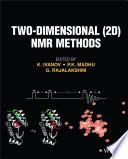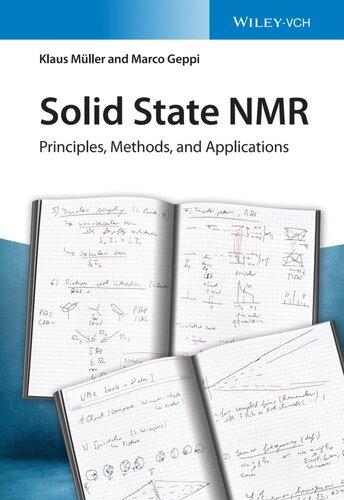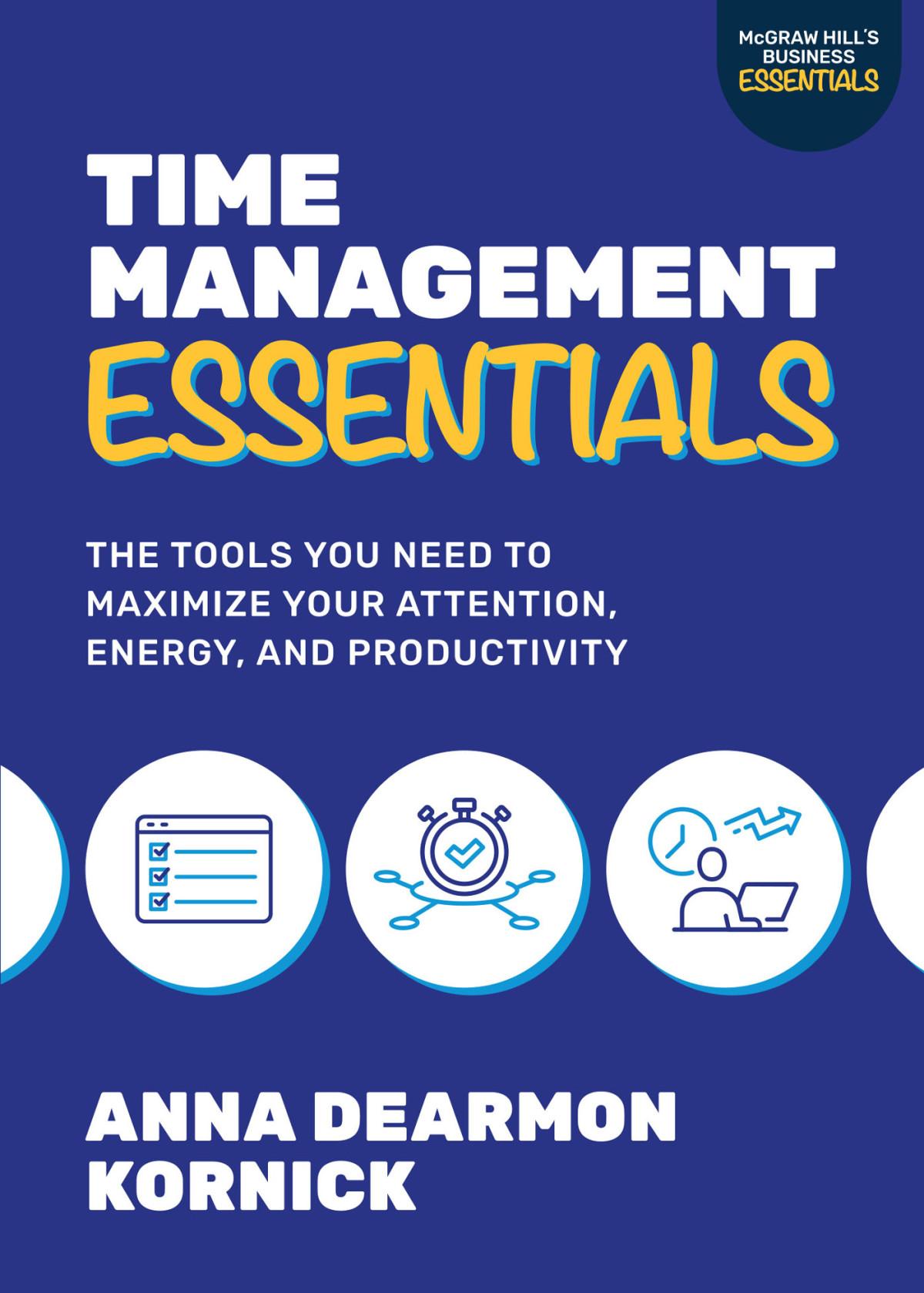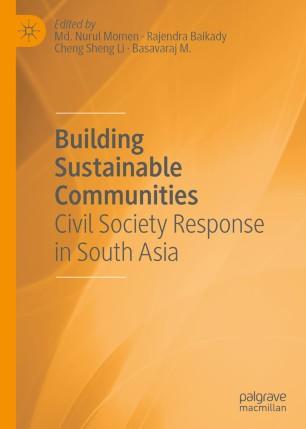Two-Dimensional(2D)NMRMethods
Editedby K.Ivanov‡
InternationalTomographyCenter,Novosibirsk,Russia
P.K.Madhu
TataInstituteofFundamentalResearch,Hyderabad,India
G.Rajalakshmi
TataInstituteofFundamentalResearch,Hyderabad,India
Thiseditionfirstpublished2023. © 2023JohnWiley&SonsLtd
Allrightsreserved.Nopartofthispublicationmaybereproduced,storedinaretrievalsystem,ortransmitted,inanyformorbyanymeans, electronic,mechanical,photocopying,recordingorotherwise,exceptaspermittedbylaw.Adviceonhowtoobtainpermissiontoreuse materialfromthistitleisavailableat http://www.wiley.com/go/permissions
TherightofK.Ivanov‡,P.K.Madhu,G.Rajalakshmitobeidentifiedastheauthorsoftheeditorialmaterialinthisworkhasbeenassertedin accordancewithlaw.
RegisteredOffice(s)
JohnWiley&Sons,Inc.,111RiverStreet,Hoboken,NJ07030,USA
JohnWiley&SonsLtd,TheAtrium,SouthernGate,Chichester,WestSussex,PO198SQ,UK
Fordetailsofourglobaleditorialoffices,customerservices,andmoreinformationaboutWileyproductsvisitusatwww.wiley.com.
Wileyalsopublishesitsbooksinavarietyofelectronicformatsandbyprint-on-demand.Somecontentthatappearsinstandardprintversions ofthisbookmaynotbeavailableinotherformats.
Trademarks: WileyandtheWileylogoaretrademarksorregisteredtrademarksofJohnWiley&Sons,Inc.and/oritsaffiliatesintheUnited Statesandothercountriesandmaynotbeusedwithoutwrittenpermission.Allothertrademarksarethepropertyoftheirrespectiveowners. JohnWiley&Sons,Inc.isnotassociatedwithanyproductorvendormentionedinthisbook.
LimitofLiability/DisclaimerofWarranty
Inviewofongoingresearch,equipmentmodifications,changesingovernmentalregulations,andtheconstantflowofinformationrelatingto theuseofexperimentalreagents,equipment,anddevices,thereaderisurgedtoreviewandevaluatetheinformationprovidedinthepackage insertorinstructionsforeachchemical,pieceofequipment,reagent,ordevicefor,amongotherthings,anychangesintheinstructionsor indicationofusageandforaddedwarningsandprecautions.Whilethepublisherandauthorshaveusedtheirbesteffortsinpreparingthis work,theymakenorepresentationsorwarrantieswithrespecttotheaccuracyorcompletenessofthecontentsofthisworkandspecifically disclaimallwarranties,includingwithoutlimitationanyimpliedwarrantiesofmerchantabilityorfitnessforaparticularpurpose.Nowarranty maybecreatedorextendedbysalesrepresentatives,writtensalesmaterialsorpromotionalstatementsforthiswork.Thefactthatan organization,website,orproductisreferredtointhisworkasacitationand/orpotentialsourceoffurtherinformationdoesnotmeanthatthe publisherandauthorsendorsetheinformationorservicestheorganization,website,orproductmayprovideorrecommendationsitmaymake. Thisworkissoldwiththeunderstandingthatthepublisherisnotengagedinrenderingprofessionalservices.Theadviceandstrategies containedhereinmaynotbesuitableforyoursituation.Youshouldconsultwithaspecialistwhereappropriate.Further,readersshouldbe awarethatwebsiteslistedinthisworkmayhavechangedordisappearedbetweenwhenthisworkwaswrittenandwhenitisread.Neitherthe publishernorauthorsshallbeliableforanylossofprofitoranyothercommercialdamages,includingbutnotlimitedtospecial,incidental, consequential,orotherdamages.
AcataloguerecordforthisbookisavailablefromtheLibraryofCongress
HardbackISBN:9781119806691;ePDFISBN:9781119806707;epubISBN:9781119806714;oBookISBN:9781119806721
CoverImages: Centreandbottomright-handimagecourtesyofNathanielJ.Traaseth.Bottomright-handimageadaptedfromFigure2from dx.doi.org/10.1021/jp303269m|J.Phys.Chem.B2012,116,7138–7144;Bottomleft-handimagescourtesyofPramodhVallurupalli.Bottom left-handimageadaptedfromFigure1fromDOI:10.1039/c5sc03886c,Chem.Sci.,2016,7,3602 CoverdesignbyWiley
Setin9.5/12.5ptSTIXTwoTextbyIntegraSoftwareServicesPvt.Ltd,Pondicherry,India
Dedication
DedicationandtributetoKostya
K.IvanovatthemeetingoftheAlexandervonHumboldtfoundationscholarshipholdersinNovosibirsk,2012.
OuresteemedcolleagueandgoodfriendKonstantinL’vovich(“Kostya”)Ivanovbecameoneofthefirstvictimsofthe Covid-19pandemicintheNMRcommunity.HepassedawayatahospitalinNovosibirskonMarch5,2021.Hewas notonlyagreatscientist,butalsoagoodhumanbeing,alwayssincere,honest,joyous,andconsiderate.Inaddition, hewasagreatcitizenofthescientificcommunity.AsidefromhisdemandingjobastheDirectoroftheInternational TomographyCenter(ITC),Novosibirsk,hekepthisresearchataveryhighlevelandorganizedamultitudeof meetings,seminars,andwebinars.
AlexandraYurkovskayametKostyaforthefirsttimein1998attheITCwhenhewasamasterstudentinthe theoreticalchemistrygroupheadedbyNikitaLukzen.HavingdefendedhisPh.D.thesisin2002attheITC,Kostya teamedupwiththeexperimentalgroupofAlexandraYurkovskayainsolvingtheoreticalproblemsrelatedto chemicallyinduceddynamicnuclearpolarization.Since2005bothofthemworkedinHans-MartinViethgroupat theFreeUniversityofBerlinaspartofthelargeEUproject"Bio-DNP"undertheleadershipofThomasPrisner.In 2007,KostyabecameafellowoftheAlexandervonHumboldtFoundationattheFreeUniversityofBerlinand
AlexandrahadaMarieCurieInternationalfellowshipwithHans-MartinViethasthehostprofessor.Thescientific collaborationhadsincecontinuedforalmost20yearsandledtoover100jointpublicationsonnuclear hyperpolarizationandpolarizationtransferprocesses,combiningmoderntheoreticalandsophisticated experimentaltechniques.Inparticular,overthelastdecade,AlexeyKiryutinfromtheYurkovskyayagroupattheITC pushedthelimitsbydevelopinguniquehigh-resolutionfastfield-cyclingNMRapparatusovernineordersof magnitudeofmagneticfield.Kostyaproposedmultiplesmartapplicationsofthetechniquetohyperpolarizationand relaxation,establishingKostyaasoneoftheleadersofanewscientificdirection.In2007,Kostyadefendedhissecond doctoralthesis,whichisthesecondscientificdegreeinRussia,awardedforasignificantandsustainable contributiontoscientificknowledge,whichisanalogoustothehabilitationdegreeinGermany.Thethesistitlewas: “Kineticsofmulti-stageliquid-phaseprocessesinvolvingparticleswithspindegreesoffreedom”.Hecompletedhis degreeattheInstituteofChemicalPhysicsinMoscow,whichistheleadinginstituteoftheRussianAcademyinthe fieldofchemicalphysics.Hisscientificworkwashonoredwithseveralimportantprizesandawards,includingthe MedaloftheEuropeanAcademyofSciencein2010,Voevodskyprizein2012,aFellowshipoftheJapaneseSociety forPromotionofSciencein2016,andtheLaukienPrizein2020forhiscontributiontotheSABREresearchfield.
ThecooperationbetweenFrench(ENS)andRussian(ITC)groupsdoingfastfield-cyclingNMRstartedin2017 withavisitofKostyatoÉcoleNormaleSupérieure(ENS,Paris)organizedbyGeoffreyBodenhausen.Thisledto severalcollaborationswithBodenhausen,DanielAbergel,andFabienFerrageontopicsasdiverseaslong-lived states,mechanismsofdynamicnuclearpolarization,andcoherenceeffectsinfield-cyclingexperiments.A comparativestudyofZULFspectroscopywithNMRdetectionusinganatomicmagnetometerandinductive detectionathighmagneticfieldwasinspiredbyKostya’stutorialtalkattheZULFseminarorganizedbytheMarie CurieZULF-NMRInnovativeTrainingNetworkinMainzinthefallof2019.Duringthoseseveralunforgettable days,followedbyfantasticmusicaleveningsincludingKostyaandDimaBudkersingingtogetherwithaband formedbyDima’sresearchgroupmembers,theatmosphereofwarmmutualcooperationwascreatedandthe fruitfulalthoughdramaticallyshortjointworkstarted.
DimaBudker’sacquaintanceandcollaborationwithKostyawerebothrelativelyshort,sometwo-threeyears, dependingonwhereonemarksthebeginning.Nevertheless,thiscollaboration,consistingofseveraljointprojectsthat haveresultedinatleastfivejointpapersandbookchapters,hashadaprofoundeffectonDima’sresearchinterests. Inmostcases,thecollaborationwasinitiatedbyKostyaandwascenteredaroundanideaformulatedbyhimwith suchclarityandenthusiasmthatitwasimpossiblenottoembracetheprojectwholeheartedly.
Thiswasalsothecasewiththechapterforthis2D-NMRbook.OntheFebruary3,2021,Dimareceivedane-mail fromKostyathatsaid:“MadhuandmyselfhavegotanofferfromWileytoeditabookon2D-NMR.Asapartofthis initiative,Iwanttocoversomeaspectsoffield-cyclingNMRandzero-fieldNMR.Although2Dmethodsarenotthat widespreadinthesebranchesofNMR,theyareusedaswellandcanbeofinteresttoNMRpeople.Wouldyouliketo writesuchachaptertogetherwithmeandFabienFerrage,withwhomIcooperateonfield-cyclingNMR?”Thiswas followedbyadetailedoutlineofthechapterproposedbyKostya.KostyaandDimathenmetonSkypetodiscussthis suggestion,includingthescopeandwhomtoinviteasco-authors.TheirlastcommunicationwasontheFebruary11, 2021,andtheyagreedtotalkagainverysoon...Thatconversationwasnotdestinedtooccur.
FabienFerrage’sfirstacquaintancewithKostyawasbyreadinghiswork,particularlytheseriesofarticleshe publishedwithHans-MartinVieth,RobKaptein,andAlexandraYurkovskayaonlevelanti-crossingsandcoherent effectsinfield-cyclingexperiments.AsFabienwasmakinghisfirststepsinrelaxometry,thesewereenlightening contributionsthatdefinedveryclearlywhatheshouldnotdoifhewantedtomeasurepurerelaxationratesatlow fields.GeoffreyBodenhausenandFabiendiscussedseveralofKostya’sarticlesbeforemeetinghim,oftenwithpraise, inparticulartheintroductionofSABREathighfield.FabienmetKostyainpersoninMay2015,whenKostyacame toParisforaCOSTmeetingonhyperpolarization.Neverwastinganytime,KostyacametoENStovisitthelaband giveaseminarduringthelunchbreakofthemeeting.Overtheyears,severalmeetingsandaninvitedprofessorship atENS(anhonourrarelygiventoscientistsofsuchayoungage),KostyaandFabiendiscussedmanytopicsonfield
cycling,relaxometry,andhyperpolarization.IfKostyawasalwaysaskingforchemicalinsightfromFabienside, FabienwasalwaysimpressedbyKostya’scommandoftheory,inquantummechanicsingeneralaswellas,ofcourse, inbothnuclearandelectronmagneticresonance,thelattersubjectbeinginvariablychallengingformanyNMR specialists.ThecollaborationbetweenFabienandKostyareallytookoffwhenIvanZhukov,atalentedgraduate studentsupervisedbyAlexandraYurkovskaya,oneofKostya’smentors,cametoworkonfieldcyclingwiththe Ferragegroupin2018.Asoftenhappens,Ivan’sworkwithatENSendedupbeingguidedbyserendipityandledusto aninvestigationofinterestingeffectsofscalarcouplingsatlowfieldsdiscussedinthisbook.Thisworkinspired KostyatoproposetheZULF-TOCSYexperiment,suchabeautifulidea,thattheyhavejuststartedexploring.
FabienFerragerecalls:Kostyawasatrueforce,initiatingandleadingmanyprojectswithintelligence,ambition andintensitywhile,atthesametime,beingthenicest,kindestandmostgenerouscolleague.Sucharare combination.KostyaandIwerebornthesameyear.Hisdaughterandmysonareaboutthesameage.Iconsidered himasacompass,settingapathtoinspireothers.InFebruary2021,weexchangedaboutthescopeofthisbook chapter.OneofthelastemailsIreceivedfromKostya,onFebruary15,2021,wasaboutaconversationhehadhad withDmitryBudkertowritethisbookchaptertogether,whichIamgladweaccomplished.OnMarch5,mycolleague DanielAbergelcalledmetoinformmethatKostyahaddied.Thecompasswasbroken,buttheinspirationliveson.
MadhurecollectshisassociationwithKostyawhichstartedin2016attheWindischleubaSchoolonNMR,aseries beingorganisedbyJoergMatysik:Wehadbeenregularteachersinthisworkshopseriesin2017,2018,and2020. Somewherein2018,westarteddiscussingtheprospectsofwritingabookonsolid-stateNMR.WemetupinLeipzig inJune2019foradiscussionregardingthis,havingdonesomeamountofwritingalready.Duringthismeeting KostyahadthiswonderfulsparkandtoldmethatwhydonotwewriteareviewonFloquettheorywithnewideas embeddedandwithmoreexamplesthanexistingreviews.Thisreviewkeptusbusytillhepassedawaywhenwewere refiningitaftercommentsfromtheeditors.Infact,weinbetweentookuptheassignmentwithWileytobringoutthis bookandKostyawas,asusual,veryenthusiasticandfullofideasaboutwhattobeincludedandhowtheyshouldbe. Writingthereviewwithhim,inparticular,wasveryrewarding.Irememberthelargenumberofextensivediscussions wehadfromwhichIlearnedquiteabit.WeactuallyhadtheSkypewindowalwaysactiveinourcomputers,and eitherofuswouldcalltheotherinformallyincaseofanyquestions.Wewerealsodiscussingsomeofthesolid-state NMRexperimentsthatmygroupwascarryingoutwhichwerethetopicsofdiscussionjustbeforehegothospitalized. Needlesstosay,theothermajorthingKostyadidforthemagneticresonancecommunitywasstartingtheFriday IntercontinentalSeminarSeriesonApril8,2020(whichwasaWednesday).Aweekbeforethatasweweretalking aboutthereview,heasusualwantedtodosomethingforthecommunity.WegotintouchwithDanielAbergeland GerdBuntkowskyandtheseminarserieshasbeenrunningsincethensmoothlywithgreattalks.AsKostyawanted,it combinestalksbyseniorandyoungerresearchers.HealsostartedtheICONSconferencein2020andjustbeforehe passedaway,wehadthesecondofthatmeeting.ICONSconferenceshavebeencontinuingsincethenonaregular basiswiththethirdheldinSeptember2021,thefourthinFebruary2022,thefifthinAugust-September2022,andthe sixthinJanuary2023.AlltheseclearlyrevealthevitalityinKostyawithasharpeyefordetails.Besidesscience,we hadfundiscussingpolitics,literature,music,andmanyotherthings.
MuslimDvoyashkinrecallsthefirstmeetingwithKostyaonthewaytoWindischleubaNMRschoolin2020, pickingupKostyaatthetrainstationinLeipzig.Kostyamadethefirstimpressionofaveryintelligentandvery modestperson,whichlaterturnedouttobequitetrue.Ashiscountryman,itwasveryinterestingforMuslimtofind outhowheandhiscolleaguesmanagetoremainattheforefrontoffundamentalsciencegivenitsverylimited financialsupportinRussia.Therefore,KostyawillremaininMuslim’smemoryasarealhero,andthankstowhom, manystudentswereabletofindtheirwaytotheacademialateron.
MalcolmLevittrecallsthathiscloseassociationwithKostyastartedaround2017whenMalcolmexpressedhis appreciationofKostya’sconferencetalkandhisinsightfultheoreticalapproach.Thisledtoextensivediscussionsand theidentificationofvariouspossiblethemesforcollaboration.Vigorousdiscussionsledtoseveralcollaborative papersonthethemeofsingletNMR.In2019MalcolmvisitedNovosibirskandhadthepleasureofgettingtoknow
Kostyaandhiscolleagues,intheir“naturalhabitat”.Itwasaverypleasantandinstructivevisit.Malcolm’smost strikingimpressionofKostyawashowhemanagedthislargeandprestigiousinstitute,fullofcompetingegos,with theminimumofperceptiblefriction,andalwayswithremarkablegoodhumour.Hewasbasicallyanextremelyrare personwhocombinedrefinedpoliticalskillswithasharpandcreativescientificmindaswellaspossessing remarkablepatienceandenergy,agreatsenseofhumour,andlegendarypowersofconcentration.Hislossis extraordinarilytragic.
WeshalldeeplymissKostyaasanexceptionalhumanbeing.Hewasacreativeandrigorousscientist,agenerous andattentivefriend,andaconsiderateandeminentlycivilizedcolleague.Wededicateourcontributionstohimand thewholebookitself,whichwasinitiatedbyKostya,thatwillbeabrilliantscientifictestamenttohismemory.
Contents
Dedication v ListofContributors xvii
Preface xix
1BasicsofTwo-dimensionalNMR 1 MalcolmH.Levitt
1.1Introduction 1
1.1.1Time-domainNMR 1
1.1.2HansPrimasandthe“CorrelationFunctionoftheSpectrum” 2
1.2SpinDynamics 2
1.2.1DensityOperator 2
1.2.2SpinHamiltonian 3
1.2.3LiouvilleSpace 3
1.2.4Liouvillian 4
1.2.5PropagationSuperoperator 6
1.3One-dimensionalFourierNMR 6
1.3.1TheOne-dimensionalNMRExperiment 6
1.3.2One-dimensionalNMRSpectrum 10
1.4Two-dimensionalNMR 11
1.4.1TheTwo-dimensionalNMRExperiment 11
1.4.2Two-dimensionalNMRSignal 12
1.4.3Two-dimensionalNMRSpectrum 13
1.4.4Two-dimensionalExperiments 13
1.5Summary 14
Acknowledgments 15 References 15
2DataProcessingMethods:FourierandBeyond 19 VladislavOrekhov,PawełKasprzak,andKrzysztofKazimierczuk
2.1Introduction 19
2.2Time-domainNMRSignal 19
2.3NMRSpectrum 20
2.4TheMostImportantFeaturesofFT 20
2.5Distortion:Phase 23
2.6Kramers-KronigRelationsandHilbertTransform 23
2.7Distortion:Truncation 25
2.8Distortion:NoiseandMultipleScans 27
2.9Distortion:SamplingandDFT 27
2.10QuadratureDetection 30
2.11Processing:Weighting 31
2.12Processing:ZeroFilling 33
2.13FourierTransforminMultipleDimensions 33
2.14QuadratureDetectioninMultipleDimensions 36
2.15ProjectionTheorem 37
2.16NDSamplingAspectsandSparseSampling 40
2.17ReconstructingSparselySampledDataSets 41
2.18Deconvolution 42
References 44
3ProductOperatorFormalism 47 RolfBoelensandRobertKaptein
3.1Introduction 47
3.2ProductOperatorsandTimeEvolution 48
3.2.1AdvantagesofProductOperators 51
3.3TimeEvolutionoftheProductOperators 55
3.3.1EffectofPulses 56
3.3.2EffectofEvolutionUndertheHamiltonian 58
3.4Applications 59
3.4.1Spin-echoExperiments 59
3.4.2Multiple-quantumCoherence 62
3.4.3CompositePulses 65
3.5Two-dimensionalExperiments 66
3.5.1Two-dimensionalJ-Resolved 67
3.5.2COSY 68
3.5.3Two-dimensionalNOE 70
3.5.4Double-quantumFilteredCOSY 72
3.5.5Two-dimensionalDouble-quantumSpectroscopy 74
3.5.6Relayed-COSY 75
3.5.7TOCSYorHomonuclearHartmann-HahnTransfer 76
3.5.8INEPTandHSQC 77
3.5.9HMQCandHMBC 79
References 81
4RelaxationinNMRSpectroscopy 93 MatthiasErnst
4.1Introduction 93
4.2Theory 95
4.2.1BlochEquations 95
4.2.2Transition-rateTheory 96
4.2.3Semi-classicalRelaxationTheory 99
4.2.4Quantum-mechanicalRelaxationTheory–LindbladFormulation 103
4.3RelaxationinSpin-1/2Systems:DipolarandCSARelaxation 104
4.3.1LongitudinalRelaxationinaTwo-spinSystem 107
4.3.2TransverseRelaxationinaTwo-spinSystem 119
4.3.3Double-quantumRelaxation 124
4.3.4RelaxationinLargerSpinSystems 125
4.4OtherRelaxationMechanisms 125
4.4.1QuadrupolarRelaxation 125
4.4.2ScalarRelaxation 128
4.5ConcludingRemarks 130
References 131
5CoherenceTransferPathways 135 DavidE.KorenchanandAlexejJerschow
5.1CoherenceTransferPathways:WhatandWhy? 135
5.2PrinciplesofCoherenceSelection 137
5.2.1Precessionofacoherenceaboutthez-componentofamagneticfield 139
5.2.2Effectofchangingthephaseofaradiofrequencypulsethatconvertsonecoherenceorderterm intoanother 139
5.3CoherenceTransferPathwaySelectionbyPhaseCycling 140
5.3.1CYCLOPS 144
5.3.2EXORCYCLE 145
5.4CogwheelPhaseCycling 146
5.5CoherenceTransferPathwaySelectionbyPulsed-fieldGradients 147
5.6ComparisonBetweenPhaseCyclingandPulsed-fieldGradients 150
5.7CTPSelectioninHeteronuclearSpinSystems 150
5.8AdditionalApproachestoCoherenceSelection 151 References 151
6NuclearOverhauserEffectSpectroscopy 153 P.K.Madhu
6.1Introduction 153
6.2NuclearOverhauserEffect 153
6.2.1QualitativePicture 153
6.2.2NOE:QuantitativePicture 155
6.2.3NOEandDistanceDependence:Many-spinSystem 159
6.2.4NOEComparisonandDistanceElucidation 160
6.2.5IndirectNOEEffects 160
6.3MeasurementofNOE 161
6.4HeteronuclearNOE 161
6.5NOEKinetics 162
6.5.1Initial-RateApproximation 163
6.6NuclearOverhauserEffectSpectroscopy,NOESY 164
6.6.1NOESYPulseScheme 164
6.6.2NOESYTheory 165
6.7Rotating-frameNOE,ROE 166
6.8RelativeSignsofCrossPeaks 168
6.9GeneralisedSolomon’sEquation 169
6.10NOESYandROESY:PracticalConsiderationsandExperimentalSpectra 170
6.11Conclusions 170
Acknowledgements 172 References 172
7DOSYMethodsforStudyingNon-equilibriumMolecularandIonicSystems 175 MuslimDvoyashkin,MonikaSchönhoff,andVille-VeikkoTelkki
7.1Introduction 175
7.2SpatialSpin“Encoding”UsingMagneticFieldGradient 175
7.3FormationofNMRSignalandSpinEchointhePresenceofFieldGradient 176
7.4NMRofLiquidsinAnElectricField:ElectrophoreticNMR 178
7.4.1MeasurementofDriftVelocities 178
7.4.2TechnicalDevelopment 181
7.4.3ApplicationAreas:FromDilutetoConcentratedElectrolytes 181
7.4.4MethodsofTransformationandProcessing:MOSY 182
7.4.5IseNMRanon-equilibriumexperimentorasteady-stateexperiment? 183
7.5UltrafastDiffusionMeasurements 186
7.6UltrafastDiffusionExchangeSpectroscopy 189 References 191
8MultipleAcquisitionStrategies 195 NathanielJ.Traaseth
8.1Introduction 195
8.2TypesofMultipleAcquisitionExperiments 195
8.3Utilizationof Forgotten SpinOperators 196
8.4ApplicationofMultipleAcquisitionTechniques 198
8.4.1SolutionNMRSpectroscopy 198
8.4.2Solid-StateNMRSpectroscopy 199
8.5ModularityofMultipleDetectionSchemesandOtherNovelApproaches 201
8.6FutureofMultipleAcquisitionDetection 202 Acknowledgments 203 References 203
9AnisotropicOne-dimensional/Two-dimensionalNMRinMolecularAnalysis 209 PhilippeLesotandRobertoR.Gil
9.1Introduction 209
9.2AdvantagesofOrientedSolvents 210
9.2.1DescriptionofOrientationalOrderParameters 211
9.2.2TheGDOConcept 212
9.3DescriptionofUsefulAnisotropicNMRParameters 213
9.3.1ResidualDipolarCoupling(RDC) 213
9.3.2ResidualChemical-shiftAnisotropy(RCSA) 215
9.3.3ResidualQuadrupolarCoupling(RQC) 218
9.3.4SpectralConsequencesofEnantiodiscrimination 219
9.4Adapted2DNMRTools 221
10.6.5UF2DNMRinSpatialInhomogeneousFields 323
10.7Conclusion 326 References 326
11Multi-dimensionalMethodsinBiologicalNMR 333
TobiasSchneiderandMichaelKovermann
11.1Introduction 333
11.2ExperimentalApproaches 334
11.2.1NMRSpectroscopicInformationonStructuralFeatures 334
11.2.2SpectroscopicInformationonDynamicalFeatures 335
11.2.3NMRSpectroscopicInformationObtainedfromInteractionStudies 336
11.2.4QuenchFlowMethodologyinCombinationwithNMR–Hydrogen-to-deuteriumExchange 336
11.2.5ExpandingMulti-dimensionalNMRSpectroscopyfrominvitrotoinvivoApplications 337
11.2.6Multi-DimensionalNMRSpectroscopyasanIntegratedApproachinStructuralBiology 337
11.3CaseStudies 338
11.3.1DeterminingThermodynamicStabilityofBiomoleculesatAtomicResolution 338
11.3.2ExoticHeteronuclearNMRSpectroscopyCorrelating 31Pwith 13C 341
11.3.3FollowingBiomolecularDynamicsbyHomonuclearandHeteronuclearZZExchange 341
11.3.4ProbingStructuralFeaturesbySolventPREs 344
11.3.5DiscerningProteinDynamicsbyProbingFastAmideProtonExchange 346
11.3.6IntegratedApproachesUtilizingStructuralInformationfromNMRSpectroscopy 348
11.3.7Multi-dimensionalNMRSpectroscopyonexvivoSamples 351 References 357
12TROSY:PrinciplesandApplications 365 HarindranathKadavathandRolandRiek
12.1Introduction 365
12.2ThePrinciplesofTROSY 366
12.2.1ThePhysicalPictureofTROSY 367
12.2.2TheoryofTROSY 369
12.3PracticalAspectsofTROSY 371
12.3.1FieldStrengthDependenceofTROSYfor 1H–15NGroups 372
12.3.2PeakPatternof 1H-15NTROSYSpectrum 373
12.4ApplicationsofTROSY 374
12.4.1Two-Dimensional[1H,15N]-TROSY 374
12.4.2[1H,15N]-TROSYforBackboneResonanceAssignmentsinLargeProteins 374
12.4.3[1H,15N]-TROSYforAssignmentofProteinSide-chainResonances 376
12.4.4Applicationof[1H,15N]-TROSYforRDCMeasurements 378
12.4.5[1H,15N]-TROSY-basedNOESYExperiments 378
12.4.6StudiesofDynamicProcessesUsingthe[1H,15N]-TROSYConcept 379
12.5TransverseRelaxation-optimizationinthePolarizationTransfers 379
12.6 15NDirectDetectedTROSY 380
12.7[1H,13C]-TROSYCorrelationExperiments 380
12.7.1Methyl-TROSYNMR 381
12.8ApplicationstoNucleicAcids 382
12.9IntermolecularInteractionsandDrugDesign 383
12.10Conclusion 383
12.AAppendix 384 Acknowledgement 385 References 385
13Two-DimensionalMethodsandZero-toUltralow-Field(ZULF)NMR 395 K.Ivanov,JohnBlanchard,DmitryBudker,FabienFerrage,AlexeyKiryutin,TobiasSjolander, AlexandraYurkovskaya,andIvanZhukov
13.1IntroductionandMotivation 395
13.2EarlyWork 396
13.3Two-dimensionalNMRMeasuredatZeroMagneticField 397
13.4NuclearMagneticResonanceatMilliteslaFieldsUsingaZero-FieldSpectrometer 403
13.5FieldCyclingNMRandCorrelationSpectroscopy 404
13.6ZERO-Field-High-FieldComparison 409
13.7ConclusionandOutlook 412 Acknowledgments 412 References 412
14MultidimensionalMethodsandParamagneticNMR 415 ThomasRobinson,KevinJ.Sanders,AndrewJ.Pell,andGuidoPintacuda
14.1Introduction 415
14.2NMRMethodsforParamagneticSystemsinSolution 416
14.2.1HomonuclearCorrelations 416
14.2.2HeteronuclearCorrelations 419
14.2.3Long-RangeParamagneticEffects 420
14.2.4HeteronuclearDetectionStrategies 421
14.3NMRMethodsforParamagneticSystemsinSolids 423
14.3.1AdiabaticPulses 423
14.3.2HomonuclearCorrelations 423
14.3.3HeteronuclearCorrelations 425
14.3.4Long-RangeParamagneticEffects 426
14.3.5SeparationofShiftandShift-anisotropyInteractions 426
14.3.6SeparationofShift-anisotropyandQuadrupolarInteractions 427 Acknowledgments 432 References 432
15ChemicalExchange 435
AshokSekharandPramodhVallurupalli
15.1Introduction 435
15.2Bloch-McConnellEquations 436
15.2.1SlowExchange 440
15.2.2FastExchange 441
15.2.3DependenceoftheLinewidthOnMagneticFieldStrength 441
15.2.4ExchangeintheAbsenceofChemical-ShiftDifferences 442
15.2.5Multi-StateExchange 442
15.3StudyingExchangeBetweenVisibleStates 443
15.3.1LineshapeAnalysis 444
15.3.2ZZ-ExchangeExperiment 444
ListofContributors
JohnW.Blanchard
QuantumTechnologyCenter,Universityof Maryland,Maryland,USA
RolfBoelens DepartmentofChemistry,UtrechtUniversity, TheNetherlands
DmitryBudker
HelmholtzInstitutMainz,Johannes Gutenberg-UniversitätMainz,Germany DepartmentofPhysics,UniversityofCalifornia, Berkeley,California,USA
MuslimDvoyashkin InstituteofChemicalTechnology,LeipzigUniversity, Leipzig,Germany
MatthiasErnst PhysicalChemistry,ETHZürich,Switzerland
FabienFerrage
LaboratoiredesBiomolécules,LBM, Départementdechimie,Écolenormalesupérieure, PSLUniversity,SorbonneUniversité,Paris,France
RobertoR.Gil DepartmentofChemistry,CarnegieMellon University,Pittsburgh,USA
BorisGouilleux UniversitéParis-Saclay,laboratoireICMMO,Orsay, France
K.Ivanov InternationalTomographyCenterSBRAS, Novosibirsk,Russia
AlexejJerschow DepartmentofChemistry,NewYorkUniversity, NewYork,USA
HarindranathKadavath LaboratoryofPhysicalChemistry,ETHZurich, Switzerland
RobertKaptein DepartmentofChemistry,UtrechtUniversity, TheNetherlands
PawelKasprzak FacultyofPhysics,UniversityofWarsaw,Warsaw, Pasteura,Poland CentreofNewTechnologies,UniversityofWarsaw, Warsaw,Poland
KrzysztofKazimierczuk FacultyofPhysics,UniversityofWarsaw,Warsaw, Poland
AlexeyKiryutin InternationalTomographyCenterSBRAS, Novosibirsk,Russia
DavidKorenchan
AthinoulaA.MartinosCenterforBiomedical Imaging,MassachusettsGeneralHospitalBoston, Massachusetts,USA
MichaelKovermann
DepartmentofChemistry,UniversitätKonstanz, Konstanz,Germany
GraduateSchoolChemicalBiologyKoRS-CB, UniversitätKonstanz,Konstanz,Germany
PhilippeLesot UniversitéParis-Saclay,RMNenMilieuOrienté, France
MalcolmH.Levitt DepartmentofChemistry,Universityof Southampton,Southampton,UK
P.K.Madhu DepartmentofChemicalSciences, TataInstituteofFundamentalResearchHyderabad, India
VladislavOrekhov DepartmentofChemistryandMolecularBiology, UniversityofGothenburg,Gothenburg,Sweden
AndrewJ.Pell
CRMN,CentredeRMNàTrèsHautsChampsde LyonUniversitédeLyon,Villeurbanne,France
GuidoPintacuda
CRMN,CentredeRMNàTrèsHautsChampsde LyonUniversitédeLyon,Villeurbanne,France
RolandRiek LaboratoryofPhysicalChemistry,ETHZürich, Switzerland
ThomasRobinson CRMN,CentredeRMNàTrèsHautsChampsde LyonUniversitédeLyon,Villeurbanne,France
KevinJ.Sanders
CRMN,CentredeRMNàTrèsHautsChampsde LyonUniversitédeLyon,Villeurbanne,France
TobiasSchneider
DepartmentofChemistry,UniversitätKonstanz, Konstanz,Germany
GraduateSchoolChemicalBiologyKoRS-CB, UniversitätKonstanz,Konstanz,Germany
MonikaSchönhoff InstituteofPhysicalChemistry,Universityof Münster,Münster,Germany
AshokSekhar MolecularBiophysicsUnit,IndianInstituteof Science,Bengaluru,Karnataka,India
TobiasSjolander DepartmentofPhysics,UniversityofBasel, Klingelbergstrasse82,Basel,Switzerland
Ville-VeikkoTelkki NMRResearchUnit,UniversityofOulu,Oulu, Finland
NathanielJ.Traaseth DepartmentofChemistry,NewYorkUniversity, NewYork,USA
PramodhVallurupalli
TataInstituteofFundamentalResearchHyderabad, Hyderabad,India
AlexandraYurkovskaya
InternationalTomographyCenterSBRAS, Novosibirsk,Russia
YvanZhukov
InternationalTomographyCenterSBRAS, Novosibirsk,Russia
Preface
NMRspectroscopyhasgrowntremendouslysinceitsinceptioninthe1940’swhenNMRsignalswerefirstrecorded byFelixBlochandEdwardPurcell.Thedevelopmentsinthefieldhavebeenfuelledbyadvancementsinvarious fields,suchas,superconductingmagnets,spectrometerhardwareandsoftware,isotopelabelling,andthetheorybehindunderstandingthevariousNMRexperiments.Theapplicationshavebeenvastfromsmallmolecules, materials,structureanddynamicsofbiomolecularcomplexestomedicalapplicationsofNMRandMRI.NMR hasbecomeastandardcharacterisationtoolinmanyChemistrylaboratoriesandwidelyusedinvariousindustrial applications,forexample,inthepharmaceuticalindustry.
OneofthemostimportantmilestonesinthetimelineofNMRisthedevelopmentof2DNMRmethods,which provideanelegantwaytogetaroundtheproblemof“spectralcrowding”andprovideversatileandhighlydetailed informationaboutmolecularstructureanddynamicsthroughcorrelationspectroscopy.Thisbookattemptstogive arigorousaccountofthebasicconceptsin2DNMRmethods,bothintermsoftheoryandapplications.Whilstthe listofcontentcoveredhereisnotexhaustive,webelieveitcertainlygivesthereaderagoodflairandcomprehensionofthefieldandnecessarybackgroundtograspmoreadvancedtopics,includinghigher-dimensionalNMR methods.
ThebookhasChaptersonthebasicsofNMR,analysisofpulsesequences,zero-toultralow-fieldNMR,NMR methodsinbiomoleculesinsolutionstate,methodsondataprocessing,pushingthefrontiersofresolution,and speedingupof2Ddataacquisition,diffusionspectroscopy,NMRofanisotropicandparamagneticsystems,and chemicalexchange.WehavealsoincludedaChapterasAppendixthatwehopewillcomplementmanyofthe otherChapters,andinparticularChapters11and12.TheChaptersareallwrittenbyleadingresearchersinthe fieldwhohavealsocontributedsignificantlytothetopicoftheirrespectiveChapter.Wehopethatthisbookwill beusefultoestablishedaswellasbeginningresearcherswhowanttoexplorethebenefitsofNMRspectroscopy andnewareasofitsmultidimensionalfacets.
Wethankalltheauthorswhohavecontributedtothisbookandalsoinatimelyfashion.Thesignificantamount ofcarethathasgoneintoeachChaptermeritsattentionanddeepacknowledgement.Wealsothankthepeople atWileyforputtingupthisbookverynicely,someofthembeing,JennyCossham,SarahHigginbotham,Elke Morice-Atkinson,andRichaJohn.
Finally,thisbookalsohasatributesectionwrittenforKostya(K.Ivanov)bysomeoftheauthors.Theconcept ofthisbookwasKostya’sidea,however,unfortunatelyhepassedawayonMarch5,2021,attheyoungageof44. Agreatscientist,afantastichumanbeing,wededicatethisbooktohismemories.
BasicsofTwo-dimensionalNMR
MalcolmH.Levitt
DepartmentofChemistry,UniversityofSouthampton,SO171BJ,Southampton,UK
1.1 Introduction
1.1.1 Time-domainNMR
Theintroductionofpulse-Fouriertransform(pulse-FT)NMRin1966byErnstandAnderson[1]representeda paradigmshift,notonlyinnuclearmagneticresonancebutalsoinmanyotherformsofspectroscopy.Priorto thisseminalexperiment,thereweretwoformsofNMR,whichweregenerallyviewedasbeingquitedistinctand practicedmainlybychemistsontheonehand,andphysicistsontheother.
ChemicalapplicationsofNMRspectroscopyuseda“continuous-wave”(cw)method,inwhichchemicalshifts andspin-spincouplingswereprobed,eitherby(i)varyingthefrequencyofappliedradiofrequencyirradiationand detectingachangeinthenuclearmagneticresponsewhentheappliedfrequencymatchesanuclearenergylevel spacing,or(ii)byapplyingradiofrequencyirradiationoffixedfrequencyandvaryingtheappliedmagneticfield whilemonitoringtheresponse.Fortechnicalreasons,thelattermethod(fixedfrequency,variablefield)waseasier toperformandmorecommon.Aresidueofthishistoricalmethodstillpersistsinthecommonnomenclatureof modernNMR,wheretheterms“highfield”and“lowfield”arestilloftenused(despiteajarringlogicalinconsistency)tocharacterizenucleiinelectronenvironments,whicharerelativelyweaklyshieldedfromtheexternal magneticfield(lowfield!),andforthosethatarerelativelystronglyshieldedfromtheexternalmagneticfield(high field!).
In1966,manyimportanttime-domainNMRexperimentsandphenonemaalsoexisted,buttheywerelargely developedandusedbyphysicists.Theseincludethespinecho[2],themodulationofspinechoesbyspin-spincouplings[3],theuseofspinechoestoprobemoleculardiffusioninafieldgradient[3],thedevelopmentofmultiple spinechoes[3,4],andHartmann-Hahncross-polarizationbetweendifferentnuclearspeciesinsolids[5].
Theintroductionofpulse-FTNMRestablishedapermanentlinkbetweenthetime-domain“physics”phenomenaandthecontinuous-wave“chemistry”procedures.
Theperturbationofnuclearspinsbyastrong,short,resonantradiofrequencypulseelicitsanextended time-domainelectricalresponsetermeda free-inductiondecay,followingBloch[6].ErnstrealizedthatFourier transformationofthetime-domainNMRsignal��(��)yieldsafrequency-domainfunction��(��),whichundercertain assumptions,isidenticaltotheNMRspectrumgeneratedfarmoreslowlybyacontinuous-wavefrequency-domain NMRexperiment:
Two-Dimensional(2D)NMRMethods,FirstEdition.EditedbyK.Ivanov,P.K.MadhuandG.Rajalakshmi. © 2023JohnWiley&SonsLtd.Published2023byJohnWiley&SonsLtd.
Inonestroke,Ernstunifiedtime-domainNMR,withitscentralobjectthefree-inductiondecay ��(��),and frequency-domainNMR,withitscentralobjecttheNMRspectrumatfixedfield ��(��).Furthermore,thisgroundbreakingtheoreticalunificationwasaccompaniedbyalargeincreaseinsignal-to-noiseratio,ofgreatpractical importance.Thetimingofthisadvancewasexceptionallyfavorable.PracticalapplicationoftheFouriertransform requiresnumericalcomputation.Sufficientlypowerfulcomputationalhardwarewasbecomingwidelyavailable, andfurthermore,afastalgorithmfornumericalFouriertransformationhadjustbeendeveloped[7].Astheysay, therestishistory.NMRwasrevolutionized,withahugeimpactonmanyothersciences,asrecognizedbyErnst’s Nobelprizein1991.ItwasprobablyoneoftheleastcontentiousNobelprizesinhistory.
1.1.2
HansPrimasandthe“CorrelationFunctionoftheSpectrum”
TheseminalcontributionofErnstandAndersoniswellknowntomostNMRspectroscopists.Lesswellknown isthatanEquationverysimilartoEquation 1.1 hadbeenpublishedbyaclosecolleagueofErnstatETH-Zürich afewyearsearlier.ThiscolleaguewasHansPrimas,whoenjoyedaparticularlyremarkablecareer.Primaswasa self-taughtgeniuswhorosetobecomeaProfessorofPhysicalandTheoreticalChemistryattheETH-Zürichand anauthorityinquantumtheoryandthephilosophyofscience,despitetheabsenceofsecondaryschooleducation orauniversitydegreeofanykind[8].The1963paperbyBanwellandPrimas[9]introducesaquantitycalledthe “correlationfunctionofthespectrum”andgivenby
(omittinganunimportantnormalizationfactor).SincetheFouriertransformisreversible,Equations 1.1 and 1.2 areentirelyequivalent(overlookingatechnicaldifferenceinintegrationlimits).BanwellandPrimasintroduced theterm ��(��) asanobjectoftheoreticalinterestandpresumablymisseditssignificanceasbeingidenticaltothe free-inductiondecay ��(��) generatedbyanuclearspinsystemsubjectedtopulseexcitation–andwascertainlynot awareofitspracticalsignificance.
ImentionPrimas’worknottodisparageErnst’sachievement–onthecontrary,IfeelthattheworkbyPrimasand colleagueshelpsusunderstandbetterthehistoricalprovenanceofErnst’sinsight.Ernst’sskillwasinmarrying thecontemporarythinkingattheETH-ZürichwiththehighlypracticalmotivationofAndersonattheVarian Corporation,withwhomErnstdevelopedtheconceptandapplicationofFT-NMR[1].
Remarkably,Equation1.2isfarfrombeingtheonlyimportantinsightinreference[9].Thispaperalsointroduces theconceptsofsuperoperatorsandLiouvillespaceandalsoanticipatesCartesianproductoperatortechniques, broughttofruitionbySørensenetal.[10]andothergroupsnearly20yearslater(seeChapter3).
1.2 SpinDynamics
1.2.1
DensityOperator
Time-domainFourierNMRismostconvenientlyanalyzedbythemodernoperatordescriptionofNMR,as expoundedinthetextbookbyErnst,Bodenhausen,andWokaun[11].
Thequantumstateofthenuclearspinsinthesampleisdescribedbyaspindensityoperator ��,defined:
where |��⟩ isthespinstateofanindividualspinsystemandtheoverbarindicatesanensembleaverage.
1.2.2 SpinHamiltonian
Inmanycases,thespinHamiltonian ℋ maybewrittenasthesumofa coherent term,whichisidenticalforall membersofthespinensemble,anda fluctuatingterm,whichisstronglytime-independent,hasadifferentvalue fordifferentensemblemembers,andazeroaverageovertheensemble:
ThecoherentpartofthespinHamiltonian ℋcoh containsterms,whichareresponsibleformajorfeaturesof theNMRspectrumsuchaschemicalshifts,spin-spincouplings,andresidualdipolarcouplingsinanisotropic phase[12].
Ingeneral,thecoherentspinHamiltonian ℋcoh possessesasetof ���� eigenstates |��⟩ andeigenvalues ����, satisfyingthefollowingeigenequation:
Whenmultipliedby ℏ,theeigenvalues ���� correspondtothequantumenergylevelsofthespinsystem.
ThefluctuatingpartofthespinHamiltonian ℋfluc(��) isresponsiblefor dissipative phenomena,includingrelaxationprocesses,whichbringthespinsystembacktoequilibriumwiththemolecularenvironmentaswellas importantdissipativeeffectssuchasthenuclearOverhausereffect,whichunderpinsmanyapplicationsofNMR tostructuralbiology[13].
1.2.3 LiouvilleSpace
Theprinciplesoftime-domainNMRareexpressedmostcompactlyin Liouvillespace,meaningthespaceofall orthogonaloperatorsforthespinsystem[11,14,15].Thedimensionofthisspaceis ����
AconvenientbasisforLiouvillespaceisgivenbyallpossibleproductsoftheketsandbrasofthecoherent Hamiltonianeigenstates,eachoperatorhavingtheform
The ���� operatorswith ��=�� areknownas populationoperators:
The ����(���� −1) operators ������ with ��≠�� areknownas coherenceoperators. Inthisrepresentation,thedensityoperatormaybewrittenasa ����-dimensionalvector,termeda Liouvilleket | | |��⟩,asfollows:
Ingeneral,theLiouvillianhas ���� righteigenkets or righteigenoperators denoted | | | | ������⟩,and ���� lefteigenbras or lefteigenoperators denoted ⟨������ | | | |,withthefollowingproperties:
wheretheindex��takesvalues{1,2…����}andΛ�� aretheLiouvillianeigenvalues.Byconvention,theleftandright eigenoperatorsarenormalized:
Theleftandrighteigenketsareorthogonaltoeachother:
wheretheKroneckerdelta ������ isequalto 1 for ��=��,and 0 otherwise.However,theleftandrighteigenoperators arenot,ingeneral,mutuallyadjoint:
TheinequalityinEquation 1.21 mayonlybereplacedbyanequalityinthecasethatrelaxationisignored, ortheenvironmentaltemperatureisassumedtobeinfinite.Inordertomaintaingenerality,theleftandright eigenoperatorsarekeptdistinctinthischapter.
TheLiouvillianeigenvaluesarecomplexingeneral,andmaybewritten
where ���� and ���� arereal,and ���� ≥ 0.Foreacheigenoperator | | | | ������⟩,thequantity ���� representsitsoscillation frequency,and ���� itsdecayrateconstant.
Eigenoperators| | | | ������⟩withrealeigenvaluesrepresentparticularconfigurationsofthespinstatepopulationsthat decaymonotonicallyandexponentially,withoutoscillating,astheevolutionproceeds.Eigenoperators| | | | ������⟩with complexeigenvalues,ontheotherhand,oscillatewhiledecaying.Theoscillationfrequencyofaneigenoperator | | | | ������⟩isgivenbytheimaginarypart���� oftheeigenvalueΛ��.Theirdecayrateconstantisgivenbythequantity����, whichisminustherealpartoftheeigenvalue Λ��
Inmostcases,aneigenoperator|
| ������⟩withacomplexeigenvalueisveryclosetoacoherenceoperator| | |������⟩,with �� ≠��.Theeigenfrequency ���� ofsuchanoperatoris(minus)thedifferenceineigenvaluesbetweentherelevant Hamiltonianeigenstates[9]:
ThecorrespondenceinEquation 1.23 isnotexactingeneral.Thisisbecausethesuperoperators ̂ ℋcoh and ̂ Γ donotalwayscommute.Thisimpliesthatnewpropertiesmayemergewhenthetwotermsarecombined.For example,therelaxationpropertiesofthespinensemblemaybeprofoundlymodifiedbychangingthecoherent Hamiltonian,evenwhentherelaxationsuperoperator ̂ Γisleftuntouched.Oneexampleistheemergenceofslowly














